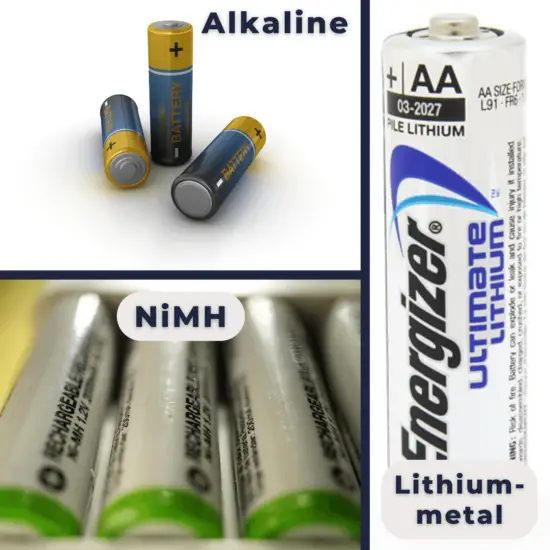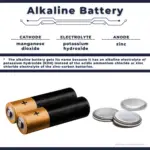30-second summary
AA Battery
An AA battery is one of the most common types of single cell cylindrical batteries. AA batteries are common in portable electronic devices.
There are several different types of AA batteries. The exact terminal voltage, capacity and practical discharge rates depend on cell chemistry. However, devices designed for AA cells will usually only take 1.2-1.5 V unless specified by the manufacturer.
Types of AA Batteries:

The AA battery is one of the most common types of single-cell cylindrical batteries. AA batteries are common in portable electronic devices.
Types of AA Batteries
AA batteries are basically divided into primary and secondary. Several different chemistries are used in their construction. The exact terminal voltage, capacity and practical discharge rates depend on cell chemistry; however, devices designed for AA cells will usually only take 1.2-1.5 V unless specified by the manufacturer.
Primary AA Battery. A primary battery or primary cell is a non-rechargeable battery that is designed to be used once discarded after use. These batteries are most commonly used in portable devices with low current drains, are used only intermittently, or are used well away from an alternative power source, such as in alarm and communication circuits where other electric power is only intermittently available. Primary cells have higher energy density than the rechargeable secondary cell, but most types of primary cells have high inner impedance and will therefore cause a big voltage drop during high discharge current, limiting the power capacity.
- Alkaline battery. An alkaline battery (IEC code: L) is a type of primary battery that provides direct electric current from the electrochemical reaction between zinc and manganese dioxide (MnO2) in the presence of an alkaline electrolyte. The alkaline battery gets its name because it has an alkaline electrolyte of potassium hydroxide (KOH) instead of the acidic ammonium chloride (NH4Cl) or zinc chloride (ZnCl2) electrolyte of the zinc–carbon batteries. The alkaline cell was introduced to the market in 1959 but did not become more common than the Zinc-carbon cell until around 1980.
- Lithium metal battery. Lithium-based primary cells are batteries that have metallic lithium as an anode. They have the lowest self-discharge rate hence the longest available shelf time, up to 10 years, and in temperatures up to 70. Using an iron disulfide cathode gives a battery with a nominal voltage of 1.5 volts. This cell is used for high-performance AA batteries.
- Zinc-carbon battery. The zinc-carbon battery, also called the Leclanché cell, is a traditional general-purpose dry cell. Zinc–carbon batteries were the first commercial dry batteries developed from the technology of the wet Leclanché cell. This battery provides a direct electric current from the electrochemical reaction between zinc and manganese dioxide (MnO2) in the presence of an electrolyte. It produces a voltage of about 1.5 volts between the zinc anode, which is typically constructed as a cylindrical container for the battery cell, and a carbon rod surrounded by the cathode that collects the current from the manganese dioxide electrode. The name “zinc-carbon” is slightly misleading as it implies that carbon is acting as the reducing agent rather than the manganese dioxide.
- Zinc-chloride battery. The zinc-chloride battery is a type of primary battery developed from a zinc-carbon cell. It is frequently referred to as a heavy-duty, extra-heavy-duty, super-heavy-duty, or super-extra-heavy-duty battery. Zinc-chloride cell is an improvement on the original zinc-carbon cell, using purer chemicals and giving a longer service life and steadier voltage output as it is used and offering about twice the service life of general-purpose zinc-carbon cells, or up to four times in continuous-use or high-drain applications.
Secondary AA Battery. Secondary batteries, also known as secondary cells, or rechargeable batteries, are batteries that can be recharged by driving electric current in the opposite direction of the discharge current. Rechargeable batteries are often more expensive, but in high-drain applications, they offer greater value as they can be reused. In low-drain applications, the service life is more important, and the self-discharge characteristics of a rechargeable battery mean that they are less suitable for use as the primary energy source.
- NiMH battery. A nickel-metal hydride battery, NiMH, is a secondary battery with a positive electrode made of nickel hydroxide and a negative electrode made of a metal hydride (a hydrogen-absorbing alloy). The NiMH battery was commercially introduced in 1989 and was mainly used as a power source in portable personal computers. Since then, the NiMH battery system has become very popular in electric hybrid vehicles and makes up 10% of the total market for rechargeable batteries. Compared to the NiCd battery, the NiMH provides 40 percent higher specific energy resulting in about two times higher capacity. NiMH batteries are also less affected by the memory effect.
- NiCd battery. The nickel-cadmium battery (Ni-Cd battery) is a type of secondary battery using nickel oxide hydroxide Ni(O)(OH) as a cathode and metallic cadmium as an anode. The abbreviation Ni-Cd is derived from the chemical symbols of nickel (Ni) and cadmium (Cd). The battery has low internal impedance resulting in high power capabilities but lower energy storage capacity compared to other battery systems. It has long cycle life and capability of rapid recharge but may suffer from voltage depression or memory effect



